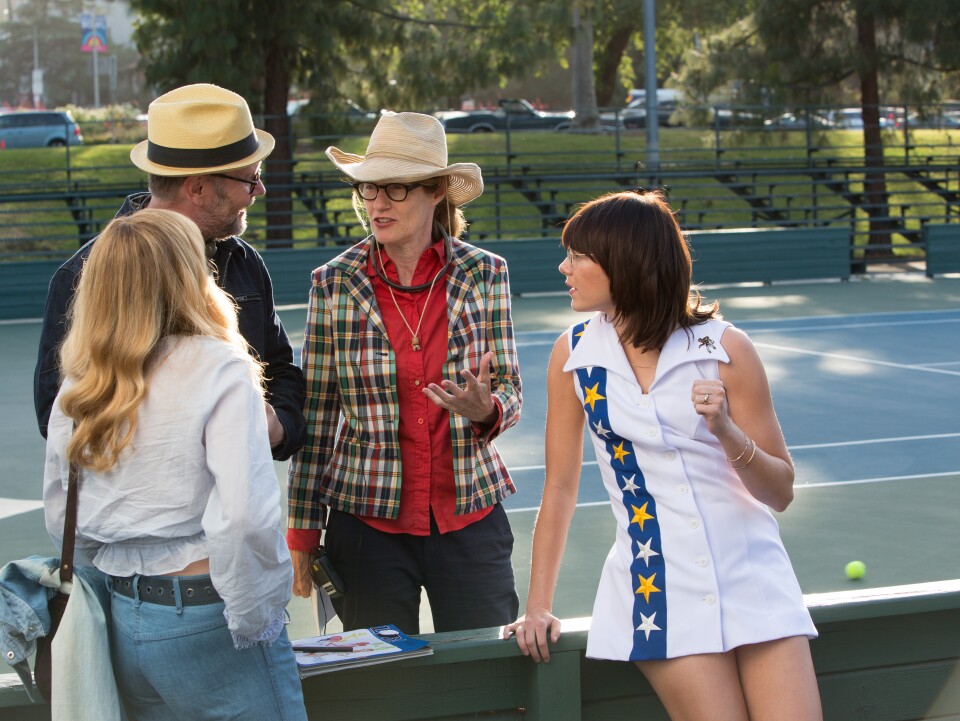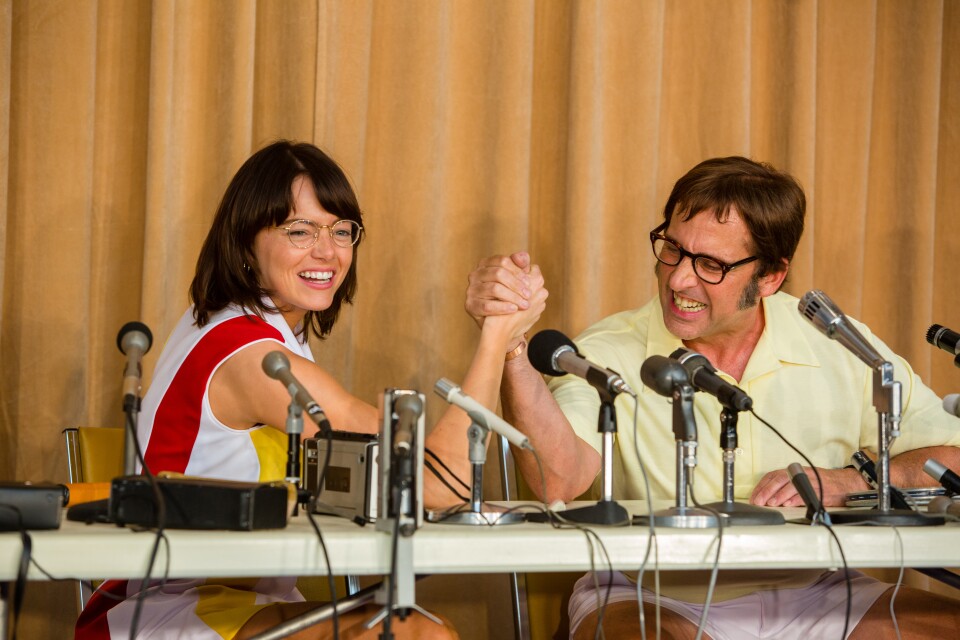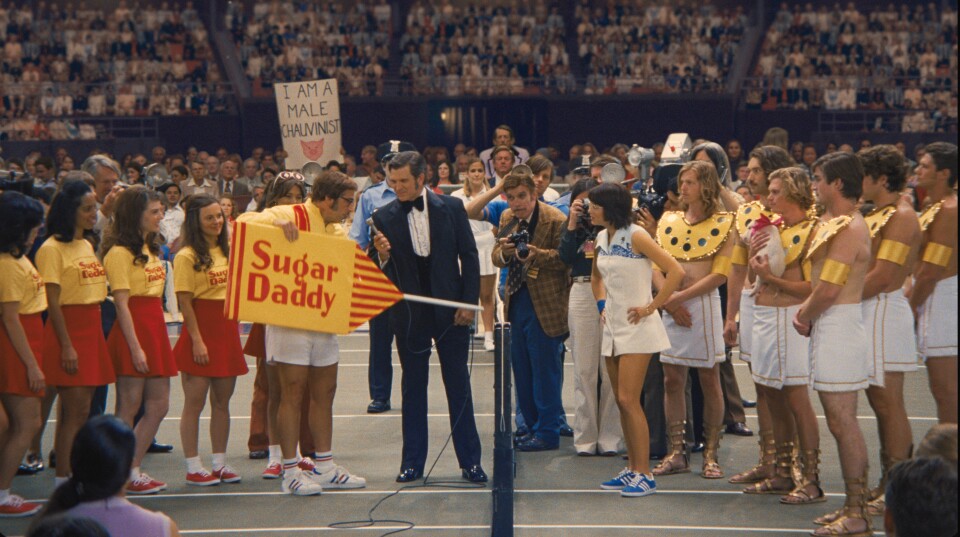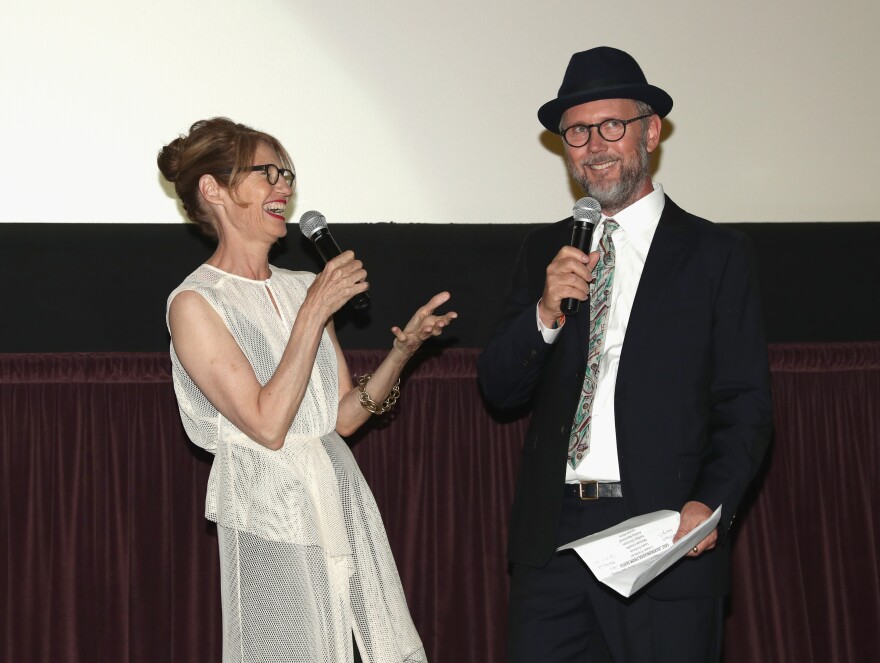Directors 'Battle of the Sexes' Valerie Faris and Jonathan Dayton ('Little Miss Sunshine') say their movie about the 1973 tennis match between Billie Jean King and Bobby Riggs is both about the public fight for gender equity and King's private struggle with her sexuality. And newly minted Emmy winner Reed Morano on directing the first three episodes of 'The Handmaid's Tale.' And what were the highs and lows of last night's Emmys? Daniel Feinberg debriefs with John Horn.
‘Battle of the Sexes’ directors say test audiences changed after 2016 election
On September 20th 1973, the 29-year-old tennis star Billie Jean King entered the Houston Astrodome on a throne adorned with pink feathers, carried by shirtless men.
Her opponent that day was 55-year-old Bobby Riggs, who entered the court surrounded by scantily clad female models. Riggs was a retired tennis champ with a gambling habit who orchestrated the event out of showmanship and chauvinism. King was the former number one women’s player in the world and was waging a battle for equal pay on the tennis circuit. She was also married to a man but secretly in her first relationship with a woman.
All of this and more factor into the new film “Battle of the Sexes,” in which Emma Stone plays Billie Jean King and Steve Carrell plays Bobby Riggs.
The movie is co-directed by the married couple Valerie Faris and Jonathan Dayton who also directed "Little Miss Sunshine." The two were finishing the movie as the 2016 election came to its conclusion. They tell The Frame that the political climate didn't change the content of their movie but that test audiences before and after November 8th changed.
Faris: We had one preview before the election and it was fine, it went well. But then the preview after the election, jumped 15 points. It was wild. Not that we care so much about the scores but it was just interesting that the audience was so primed for it. We didn't really change our direction for the film, but the audience changed.
Our conversation with Faris and Dayton was recorded at the Telluride Film Festival where the movie made its world premiere. Also in Telluride we spoke with Billie Jean King about what she hoped the movie could do and with Emma Stone about how she approached playing this icon at a time in her life when Billie Jean was in a state of turmoil.
Below are excerpts from John Horn's interview with Faris and Dayton. To hear the full conversation, click on the player above or get The Frame's podcast on itunes.
Interview Highlights
On telling the private side of Billie Jean's story:
Faris: The thing that she said to us from the beginning was, "I just want this to be empowering for kids who are struggling with their sexuality." We really took that to heart. I think that was probably the strongest and the most important point.
Dayton: She talks about it as being the most confusing part of her life. She really wasn't very happy, and yet she was doing some very important things. So we wanted to honor that and we wanted to show a person in all her imperfection, because we idolize people and simplify them. We wanted to try to keep the complexity of her life at that time.

On getting permission to use Howard Cosell's voice:
Dayton: In studying the match, we actually took the original TV broadcast and cut it down, and made what was our version of it. Then we could show that to everyone involved, so everyone knew. We even put music to it, so we got a feeling of what it was going to be like. We grew up with [sports journalist] Howard Cosell. He was this American icon and it was very important for us not to have an imitator. We wanted the real guy. So we wrote this very passionate letter to his estate just saying, "Please, would you allow us to use him - his image and his voice." There are moments where he talks about Billie Jean: "If she just took off her glasses and let her hair down, she'd look like a movie star."
Faris: "She's walking more like a male than a female!" And then he defends Bobby...
Dayton: It was such a pleasure to be able to put that in the movie. You don't need to write special lines. It's there.

On steering clear of polarizing politics:
Dayton: It was very important to us not to be yet another polarizing voice in the culture. So there are "bad guys" in the film, but we didn't want to just reduce people to chauvinist cliches
Faris: We want everybody to see this film and I think that's why her personal story was our guide through the whole story. As long as we stay close to her emotionally, it felt like we could stay away from politically taking sides.

On their own gender dynamic as a directing team:
Faris: It's funny because we do everything together. We raise three kids together. So we don't divide by gender really. We both do everything. We're so fifty-fifty. If anything, this film made us realize how much we do that, and how much we don't follow the typical gender roles in our relationship... For example, it was Jonathan's idea to put my name first in the directed-by credit. So I don't think about it so much because we've always worked together and we've always shared every responsibility.
How 'Handmaid's Tale' director Reed Morano brought Margaret Atwood's dystopia to life
Elisabeth Moss stars in the new Hulu series, "The Handmaid’s Tale," based on the acclaimed 1985 novel of the same name by Margaret Atwood.
The story takes place in a not-so-distant future America. Pollution and disease has rendered most women infertile and a theocratic military dictatorship has taken control of the country, renaming it the Republic of Gilead.
Women there are stripped of their rights and separated by class and ability to bear children. Handmaids are women who are believed to have the ability to conceive, and are kept by wealthy elites to have babies for them.
Director Reed Morano — who is also a cinematographer by trade — was tasked with creating the look and tone of this world. She directed and executive produced the first three episodes of “The Handmaid's Tale” and laid the foundation for the rest of the series.
Interview Highlights:
On translating a text from 1985 for a 2017 audience:
We drew on Margaret's book for all the inspiration, but we did make little changes here and there to update the story and make it as believable as possible, so that when you're watching, it's hitting maybe a little too close to home. The interesting thing about "The Handmaid's Tale" is that everything that happens in it has happened or is happening somewhere in the world. There is an element in the style of the show where you feel this raw closeness to the characters that maybe, when you're watching it, you get lost enough in the story that you start to feel like it's maybe getting to you.
On creating contrast between Gilead and America:
The story is told primarily through [Elisabeth Moss' character] Offred's point-of-view, and so it's her memories of these things. I always try to treat it that way. In terms of keeping it as real as possible, for example, in Gilead, women are not allowed to read. Letters and signage of any kind is forbidden. So when we return to the past, the flashback world, I was encouraging our costume designer to put clothes that had writing on them — things you would never see in Gilead. I would always bring in music — some kind of music that just spells out freedom, but you would never hear it in Gilead — all these kinds of things that we see on a daily basis here and don't bat an eyelash about.
But if we were to have all these rights stripped away from us, all these privileges and freedoms that we take for granted would suddenly become so foreign. So the idea of seeing these women buttoned up all the time in Gilead — it's really the contrast between the two worlds. I start the scene with an extreme close up with Elisabeth Moss' cleavage because she's wearing a jogging bra. She's sweating and wearing minimal clothing, and if you were in Gilead that would just be unbelievable.
On coming up with costume design that felt grounded in present day:
It was a little tricky because there is something about — in the description of Margaret's book — the look of the handmaids. We went closer toward what was written in the book. I didn't ever want the world to go too far into the past — the look of their costumes or the locations. And I never wanted it to go too far into the future. It was riding a fine line and we had many interesting conversations about it. So when we were coming up with the dress that the handmaids wore, it did have elements of the past.
Ane Crabtree, our costume designer, who's amazing, was wanting to put a zipper on the back of the dress. The dress is almost a bit modern in a weird way, and also you have this puritanical bonnet called "the wings" when they're outside, which is so graphic and amazing. Then with the wives, they have these dresses that [seem] like dresses of the '50s, yet they also have modern elements, like zippers and modern material, as well as these modern colors. We were always riding this very fine line with costume design between the past and the present.
Margaret set up this world that is very graphic and visual by nature, and so it was great because we were able to take her concept and play with that and use it toward the look of the show, making it very graphic and compelling to watch.
On negotiating opinions of shooting with cinematographer Colin Watkinson:
What it was going to come down to was personality. If we get along then we're going to be able to find a middle ground. What I liked about Colin was blending our two very specific styles — for the show to have a hybrid. I'm known for gritty realism and naturalistic kind of lighting and a very emotional camera, and he's know for his work as kind of glossy and grand. I don't want to step on the DP's toes. That's the first lesson I learned when I started directing with other cinematographers. I know how a cinematographer wants to be treated by their director and so I already have a leg up in that department and I know what would be insulting to say to a DP because I've been one for so long. I just wanted to treat him the way I wanted to be treated.
On relinquishing the role of director for later episodes:
To be honest, it was very tricky. It was a crazy endeavor doing these three episodes. It was kind of like doing three features back to back ... By the time that I got to the end of [editing episode] three, I was ready to take a break from the world of Gilead, because it is a hard world to exist in and it's a lot of responsibility just doing that many episodes back-to-back. But I was bummed. Obviously it hurts to establish such a specific way of storytelling — such a specific narrative language — that really came from my pitch book when I pitched the show. So many of those concepts are the rules of our series. Then I [had] to just walk away. I was ready to take a break from the world because it is so oppressive, but at the same time I'm like, I wish I could have done all the episodes.
On some points from her pitch book:
I made specific references, from a visual standpoint, of Kubrick-ian compositions mixed with Impressionistic fairytales — almost like a romantic camera for the flashbacks. This idea of being wide and close and up in the actor's face. Also creating a visceral window into Offred's internal psyche. I also pitched how to use humor and the voice over and how to use music. I also talked very extensively about sound design and how the sound would be heightened and become a very surreal soundscape — the kind of thing you play around a lot with in narrative features but you don't see often in TV.




